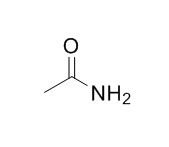Acetamide
Acetamide (2.88 g/kg/d) can reduce central nervous lesions, but the efficacy is not improved after increasing the dose.
Inquire / Order:
manager@chemfaces.com
Technical Inquiries:
service@chemfaces.com
Tel:
+86-27-84237783
Fax:
+86-27-84254680
Address:
1 Building, No. 83, CheCheng Rd., Wuhan Economic and Technological Development Zone, Wuhan, Hubei 430056, PRC
Providing storage is as stated on the product vial and the vial is kept tightly sealed, the product can be stored for up to
24 months(2-8C).
Wherever possible, you should prepare and use solutions on the same day. However, if you need to make up stock solutions in advance, we recommend that you store the solution as aliquots in tightly sealed vials at -20C. Generally, these will be useable for up to two weeks. Before use, and prior to opening the vial we recommend that you allow your product to equilibrate to room temperature for at least 1 hour.
Need more advice on solubility, usage and handling? Please email to: service@chemfaces.com
The packaging of the product may have turned upside down during transportation, resulting in the natural compounds adhering to the neck or cap of the vial. take the vial out of its packaging and gently shake to let the compounds fall to the bottom of the vial. for liquid products, centrifuge at 200-500 RPM to gather the liquid at the bottom of the vial. try to avoid loss or contamination during handling.
Molecules.2021, 26(18):5665.
Agriculture.2022, 12(3), 342.
Ajou University2024, 4688116
Molecules2022, 27(12):3903.
Antioxidants (Basel).2021, 10(3):379.
Life (Basel).2022, 12(12):2107.
Applied Biological Chemistry2022, 65(12)
Int J Mol Sci.2022, 23(21):13112.
Molecules.2023, 28(4):1785.
Universitat Stuttgart2022, opus-12200.
Related and Featured Products
Zhonghua Lao Dong Wei Sheng Zhi Ye Bing Za Zhi. 2014 Jun;32(6):438-41.
Effects of acetamide at different doses on expression of amino acids in cerebral cortex of rats with acute tetramine poisoning.[Pubmed:
25169228]
To investigate the effects of Acetamide at different doses on the expression of inhibitory amino acids (gamma-aminobutyric acid, GABA) and excitatory amino acid (glutamate, Glu) in the cerebral cortex of rats with acute tetramine (TET) poisoning.
METHODS AND RESULTS:
Eighty Sprague-Dawley rats (SPF) were randomly divided into five groups, with 16 rats in each group: saline control group, dimethyl sulfoxide (DMSO) control group, TET exposure group, high-dose (2.8 g/kg/d) Acetamide treatment group, and super-high-dose (5.6 g/kg/d) Acetamide treatment group. Rats in the exposure group and treatment groups were exposed to TET by intragastric administration after fasting, and were then intramuscularly injected with saline or different doses of Acetamide in the following 5 days.The changes in the high-dose Acetamide treatment group were similar to those in the TET exposure group, but became more like those in the control groups after 48 h; the OD value in super-high-dose Acetamide treatment group was significantly higher than that in the TET exposure group at 3 h after treatment (P < 0.01), while no significant difference was found at 12 h; it was significantly lower than those of all other groups at 48 h and 7 d (P < 0.01).
CONCLUSIONS:
Treatment with high dose of Acetamide has some curative effect on TET poisoning-induced central nervous lesion, while the effect of super-high-dose Acetamide on expression of neurotransmitters is too complex to evaluate.
Zhonghua Lao Dong Wei Sheng Zhi Ye Bing Za Zhi. 2014 Apr;32(4):289-92.
Effect of acetamide on histopathology in cerebral cortex of rats with tetramine poisoning.[Pubmed:
24754949]
To observe the effect of different doses of Acetamide on the histopathology in the cerebral cortex of rats with tetramine (TET) poisoning and to provide a basis for the treatment of fluoroAcetamide poisoning with Acetamide.
METHODS AND RESULTS:
Eighty clean Sprague-Dawley rats were randomly divided into five groups: saline control group,dimethylsulfoxide water solution control group,TET poisoning group, Acetamide (2.88 g/kg/d) treatment group, and Acetamide (5.68 g/kg/d) treatment group, with 16 rats in each group. The light microscopy showed that the TET poisoning group had hypoxia changes in the cerebral cortex, which worsened over time; the treatment groups had reduced hypoxia changes, and the Acetamide (2.88 g/kg/d) treatment group had more reduction than the Acetamide (5.68 g/kg/d) treatment group. The electron microscopy showed that the apoptosis of neuronal cells were the main pathological changes in the TET poisoning group; the treatment groups had reduced apoptotic changes, and the Acetamide (2.88 g/kg/d) treatment group had more reduction than the Acetamide (5.68 g/kg/d) treatment group.
CONCLUSIONS:
No pathological changes associated with the synergistic toxic effect of Acetamide and TET are found in the cerebral cortex. Acetamide (2.88 g/kg/d) could reduce central nervous lesions, but the efficacy is not improved after increasing the dose. For patients who cannot be identified with TET or fluoroAcetamide poisoning, Acetamide could be considered for treatment.



